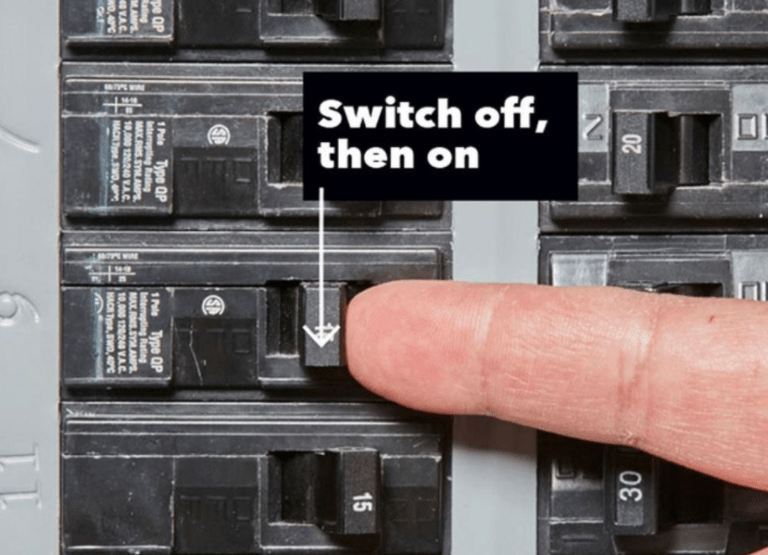If you keep experiencing a tripped circuit breaker, you know how frustrating it can be. Those continual circuit breaker trips leave you without electrical power in one or more outlets or even a whole room of your house … yet you’re in the dark (pun intended) as to the reason.
To shed a little light on the subject, here’s an explanation for why your circuit breaker keeps tripping and if you need to replace your electrical panel.
What is a Circuit Breaker?
The basic function of a circuit breaker is to interrupt an electrical current flow in order to protect electrical equipment plugged into the same circuit. The circuit break is installed in an electrical panel (or breaker panel) and all of your home’s electrical circuits are each attached to a singular breaker.
How Do You Know If Your Breaker Has Tripped?
When one or more of your appliances and/or lights suddenly shuts off, the cause is often a circuit breaker tripping in your residential electrical panel.
In the event of a circuit overload, the circuit breaker trips that circuit to protect it. You’ve likely experienced the circuit breaker tripping as soon as you try to run too many appliances or electronics at once, but a bigger concern is if your circuit breaker keeps tripping for no apparent reason that you can see.
What Is The Breaker Doing When It Trips?
Strange as it may seem, a breaker trip is actually a good thing. Your breakers are designed to trip in case of excess electrical current. This safety measure shuts off the current to help protect your electric circuits (and by extension, your home and family) from overloading, heating up and possibly causing an electrical fire.
Inside a circuit breaker you will find a spring hooked over a small piece of soft metal (a melt-able fusible alloy). Each breaker in the panel is then connected to an electrical wire that runs through your house to your electrical plugs and lights. The electricity that flows through your house runs through the soft metal.
When the connected wiring is at risk of overheating (especially when you have aluminum wiring installed), this small piece of metal melts, resulting in the spring extending and pulling the switch off and shutting down that particular circuit. When the metal cools down and hardens, the breaker can then be reset.
A regular fuse works in a very similar way, but instead of a spring, the “melt-able” metal is the bridge itself. When overheated, it melts (or pops) and breaks the connection. Fuses must be replaced each time there is a fault, while circuit breakers can be switched back to an “on” position.
What Does It Look Like When The Breaker Trips?
Take a look at your service panel (TIP: Keep a flashlight handy next to the panel, in case nearby lights are affected.). Normally, the breakers are lined up in neat rows, all in the ON position. However, when a breaker trips, the breaker switch will move so that it is sitting in the middle or the off position. It is actually quite easy to see which breaker tripped as it won’t be lined up with the other breakers in its row.

What To Do First When Your Breaker Trips
Start by turning off and unplugging all appliances and lights that went out when the breaker tripped. Then flip the tripped breaker all the way off and then back to the ON position.
6 Common Reasons For Your Breaker to Trip
1. Overloaded Circuit
An overloaded circuit means that the demand for electricity exceeds the circuit’s capacity. (In other words, you’ve got too many gizmos connected to that circuit or one gizmo – such as an air conditioner or clothes dryer — which is drawing an extra-large amount of power.) The classic example of an overloaded circuit is when someone tries to plug an enormous display of holiday lights into a single outdoor plug.
A classic example is installing a hot tub that keeps tripping your circuit breaker.
How Do You Know If Your Circuit Is Overloaded?
Besides the fact that your breaker keeps tripping, you’ll probably notice other warning signs, such as lights dimming when you turn on additional items connected to that circuit.
To solve the problem, redistribute the load by leaving some devices unplugged or connecting them to a different circuit. Large appliances may need their own dedicated circuit. Consider upgrading your electrical panel so it can safely power all your electrical gadgets.
2. Short Circuit
Yes! Short circuits can be dangerous and cause electrical fires.
So, what causes short circuits?
Short circuits are caused by wiring problems, in either:
1) a device that is plugged into an outlet on that electrical circuit
2) the circuit itself. (Called a “hard short,” the latter type of short circuit means that a neutral white wire is coming into contact with a hot (powered) black wire.)
How To Prevent Short Circuits?
Inspect electrical appliances outlets regularly for signs of damage, such as a frayed power cord or scorching. Have a professional electrician perform a home electrical safety inspection checklist at least once per year. If a breaker keeps tripping as soon as you reset it, that is a strong indication you have a short circuit – so stop trying to reset and call an electrician to check it out.
3. Arc Fault
What Are Arc-Fault Circuit Interrupters (AFCIs)?
Arc-Fault Circuit Interrupters are an advanced kind of circuit breaker. AFCIs detect power fluctuations due to dangerous arcing (sparking) between electrical contact points, often the result of loose connections. Because AFCI circuit breakers take only fractions of a second to react by tripping, they are more reliable than a standard circuit breaker for keeping your home safe.
Never ignore an AFCI circuit breaker that keeps tripping. It is a red flag for an electrical problem that needs expert attention – fast!
4. Ground Fault
What Are Ground Fault Circuit Interrupters (GFCIs)?
Ground Fault Circuit Interrupters (GFCIs) protect against short circuits that result from a hot wire touching a ground wire, a metal wall box, or wooden framing. Ground faults can cause lethal electric shock and are particularly hazardous in combination with liquid – in your kitchen, bathroom, outdoors, etc. That’s why the Canadian Electrical Code requires GFCI installation for any outlet near a source of water.
If you have a ground fault anywhere in your home electrical system, your circuit breaker may tend to trip again as soon as it is reset.
5. Power Surges
Power surges occur when your home’s electrical system receives a massive spike of electrical current. This overload will cause your circuit breaker to trip, stopping the current flow before it reaches your valuable plugged-in appliances or electronics.
Most of the time, power surges are harmless, and are nothing more than a brief increase in the level of electricity getting forced through your electrical system.
But a sudden external surge is what happens when something outside of the electrical system is causing the power surge, such as lightning strikes. While these are rarer, they’re far more likely to cause damage to your home’s electrical system—or worse, your home itself.
6. Outdated Wiring
Wiring is a key factor in the distribution of electricity. If you have an older house, your wires might have been set up improperly, or have simply degraded or been damaged over time. Either way, the system offers little in the way of electrical resistance. This means that any conductive material that comes in contact with that wiring can spike the wire’s current to dangerous levels, causing a power surge.
Faulty wiring can be indicated by a frequently-tripping circuit breaker. Keep an eye out for other signs, too, such as visible scorch marks on outlets, a burning smell, vibrations or a buzzing sound coming from your outlets. Anything that causes your outlet to stop working is a cause for concern.
Power Your Calgary Home Safely With Sun Electrical
If you’re having issues with breaker trips, contact Sun Electrical for a Calgary-area electrical panel safety inspection, electrical service upgrade, and/or expert electrical repair. We’ll keep your power on … safely.





